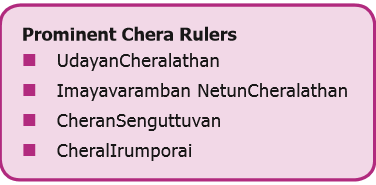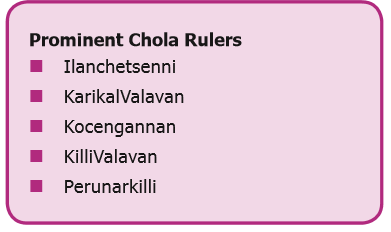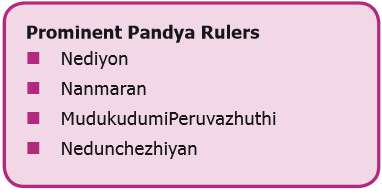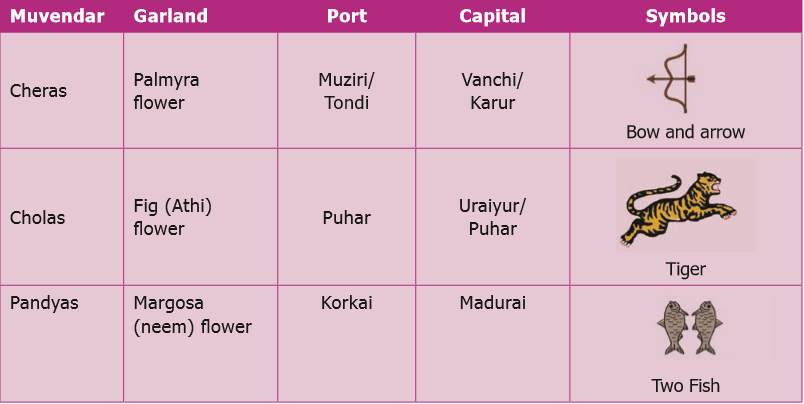Society and Culture in Ancient Tamizhagam: The Sangam Age Notes 6th Social Science
Society and Culture in Ancient Tamizhagam: The Sangam Age Notes 6th Social Science
6th Social Science Lesson 16 Notes in English
16. Society and Culture in Ancient Tamizhagam: The Sangam Age
1. What does the word Sangam Refers to?
The word ‘Sangam’ refers to the association of poets who flourished under the royal patronage of the Pandya kings at Madurai.
2. What is Sangam Age?
The poems composed by Sangam poets are collectively known as Sangam literature. The period in which these poems were composed is called the Sangam Age.
3. Various Sources of Sangam Age:
Inscriptions
Hathigumpha Inscription of King Karavela of Kalinga, Pugalur (near Karur) Inscription, Ashokan Edicts II and XIII, and inscriptions found at Mangulam, Alagarmalai and Kilavalavu (all near Madurai)
Copper Plates
Velvikudi and Chinnamanur copper plate.
Coins
Issued by the Cheras, Cholas, Pandyas and the chieftains of Sangam Age as well as the Roman coins
Megalithic Monuments
Burials and Hero stones
Excavated Materials from
Adichanallur, Arikamedu, Kodumanal, Puhar, Korkai, Alagankulam, Uraiyur
Literary Sources
Tholkappiyam, Ettuthogai (eight anthologies ), Pathupattu (ten idylls), PathinanKeezhkanakku (a collection of eighteen poetic works), Pattinapalai and Maduraikanji .
Epics
Silapathikaram and Manimegalai .
Foreign Notices
The Periplus of the Erythrean Sea , Pliny’s Natural History, Ptolemy’s Geography , Megasthenes’s Indica , Rajavali , Mahavamsa and Dipavamsa
Time Span
3rd century BC (BCE) to c. 3rd century AD (CE)
Tamizhagam
Vengadam (Tirupathi hill) in the north to Kanyakumari (Cape Comorin) in the south, Bounded by sea on the east and the west.
Age
Iron Age
Culture
Megalithic
Polity
Kingship
Dynasties ruled
The Cheras, the Cholas and the Pandyas
6th Social Book Back Questions
4. Explain the Importance of Kallanai:
It was a dyke, built with stones. It was constructed across the Kaveri to divert water throughout the delta region for irrigation. When it was built, Kallanai irrigated an area of about 69,000 acres.
5. Who were Muvendars?
Muvendars (Three Great Kings) controlled the territories of Tamizhagam during the Sangam Age. The Tamil word ‘Vendar’ was used to refer to three dynasties, namely the Cheras, Cholas and Pandyas.
6. Explain Chera era:
The Cheras ruled over the central and north Travancore, Cochin, south Malabar and Kongu region of Tamil Nadu. The Pathitrupathu (a collection of ten decades of verses) provides information about the Chera kings.
7. Who was Cheran Senguttuvan?
It is known that the Chera king Senguttuvan went on a military expedition to North India. He brought stones from the Himalayas for making the idol of Kannagi, an epic character from Silappathikaram . He introduced pattini cult.
8. Who was the Author of Silapathikaram?
CheranSenguttuvan’s younger brother was Ilango Adigal. He was the author of Silappathikaram .
9. Who issued Chera coins?
Another Chera king, CheralIrumporai, issued coins in his name. Some Chera coins bear their emblem of bow and arrow.
10. Which were the places of Chola Kingdom?
The Chola kingdom of Sangam period extended upto Venkatam (Tirupathi) hills. The Kaveri delta region remained the central part of the kingdom. This area was later known as Cholamandalam.
11. Explain the Importance of Karikalan?
- KarikalValavan or Karikalan was the most famous of the Chola kings. He defeated the combined army of the Cheras, Pandyas and the eleven Velir chieftains who supported them at Venni, a small village in the Thanjavur region.
- He converted forests into cultivable lands. He built Kallanai (meaning a dam made of stone) across the river Kaveri to develop agriculture.
- Their port Puhar attracted merchants from various regions of the Indian Ocean. The Pattinapaalai , a poetic work in the Pathinenkeezhkanakku , gives elaborate information of the trading activity during the rule of Karikalan.
12. Explain the Importance of Pandyas?
The Pandyas ruled the present-day southern Tamil Nadu. The Pandya kings patronized the Tamil poets and scholars. Several names of Pandya kings are mentioned in the Sangam literature.
13. Who was Nedunchezhiyan?
Nedunchezhiyan is hailed as the most popular warrior. He defeated the combined army of the Chera, Chola and five Velir Chieftains at Talayalanganam. He is praised as the lord of Korkai.
14. Explain the coins of Pandyas?
Pandya country was well known for pearl hunting. Pandya kings issued many coins. Their coins have elephant on one side and fish on another side. MudukudimiPeruvazhuthi issued coins to commemorate his performance of many Vedic rituals.
15.

16.

17.

18. Important Places of Sangam Period:

19. The Titles Assumed by Muvendars:

20. Important Authours who discovered the Sangam Age:
ArumugaNavalar (Jaffna), U.V.Swaminatha Iyer and Damodharam Pillai (Jaffna) strove hard and spent many years in retrieving and publishing the Tamil classics and the ancient Tamil texts, which were originally present as palm leaf manuscripts.
21. Tholkappiyam is a work on Tamil grammar. It represents the quality of Tamil language and the culture of Tamil people of the Sangam Age.
22. Who told that Tamil is as old as Latin?
George L. Hart, Professor of Tamil language at the University of California, has said that Tamil is as old as Latin. The language arose as an entirely independent tradition with no influence of other languages.
23. What is Royal Insignia?
Sceptre ( kol ), drum ( murasu ) and white umbrella ( venkudai ) were used as the symbols of royal authority.
24.Other Minor Kings:
Minor Chieftains – Ay, Velir and Kizhar. Apart from three great kings, there were several brave independent minor chieftains. The name ‘Ay’ is derived from the ancient Tamil word ‘Ayar’ (meaning shepherd). Among Ay chiefs of Sangam Age, Anthiran, Titiran and Nannan were the important names.
25. Who were Velir?
The Velirs–Vellalars– constituted the ruling and land-owning class in the ancient Tamizhagam. The famous Velirs were the seven patrons ( KadaiyezhuVallalgal ). They were Pari, Kari, Ori, Pegan, Ay, Adiyaman and Nalli. They were popular for their generous patronage of Tamil poets. Kizhar was the village chief.
26. DefineKingship
The kingship was hereditary. The king was called Ko . It is the shortened form of Kon . Vendan, Kon, Mannan, Kotravan and Iraivan were the other titles by which the king was addressed .
27. Kingship in Sangam Age:
- The eldest son of the reigning king generally succeeded to the throne.
- The coronation ceremony was known as arasukattilerudhal or mudisoottuvila.
- The crown prince was known as komahan, while the young ones were known as Ilango, Ilanchezhiyan and Ilanjeral.
- King held a daily durbar ( naalavai ) at which he heard and resolved all the disputes.
28. Define Tax System is Sangam Period:
The income to the state was through taxation. Land tax was the main source of revenue and it was called ‘ Irai’. This apart, the state collected tolls and customs ( sungam ), tributes and fines.
29. What is Heroic Anklet?
The kings and soldiers wore the heroic anklet (Veera kazhal). On the anklet, the name and achievement of the wearer were blazoned.
30. Court System in Sangam Age:
The king’s court was called Arasavai. The king occupied a ceremonious throne in the court called Ariyanai. In the court, the king was surrounded by officials, distinguished visitors and court poets.
31. What are the Five fold Duties of Rulers?
The rulers had five-fold duties. They were encouraging learning, performing rituals, presenting gifts, protecting people and punishing the criminals. Ambassadors were employed by the kings. They played a significant role.
32. How was the King Assisted?
The king was assisted by a number of officials. They were divided into Aimperunguzhu (five-member committee) and Enberaayam (eight-member group).
33. Army in Sangam Age:
The king’s army consisted of four divisions, namely, infantry, cavalry, elephants and chariot force. The army was known as ‘ Padai’. The chief of the army was known as Thanaithalaivan.
34. Various Weapons used by the Sangam People:
- The prominent weapons used during this period were sword, kedayam(shield), tomaram (lance), spears, bows and arrows.
- Tomaram is mentioned as a missile to be thrown at the enemy from a distance.
- The place where the weapons were kept was known as paddaikottil .
- The forts were protected by deep moats and trenches. The war drum was worshipped as a deity.
35. Explain the Judicial System:
The king was the final authority for appeal. In the capital town, the court of justice was called Avai. In the villages, Mandram served as the place for dispensing justice.
36. How the cases are held?
In civil cases, the method of trial followed was to call upon the plaintiff to thrust his hand into a pot containing a cobra. If the cobra bit him, he was sentenced; if the cobra did not bite him he was considered innocent and acquitted. Punishment was always severe. Execution was ordered for theft cases.
37. Various Punishments for Mistakes:
The punishment awarded for other crimes included beheading, mutilation of the offending limbs of the body, torture and imprisonment and imposition of fines.
38. Explain the local Administration:
- The entire kingdom was called Mandalam .
- Mandalam was divided into Nadus .
- Kurrm was subdivision of Nadu.
- The Ur was a village, classified into perur (big village), Sirur (a small village) and Mudur (an old village) depending upon its population, size and antiquity.
39. Various Places and their names:
Pattinam was the name for a coastal town and Puhar was the general term for harbour town.
40. Important Towns in Sangam Period:
Puhar, Uraiyur, Korkai, Madurai, Muziri, Vanji or Karur and Kanchi.
41. How were the Lands Classified?
Land was classified according to its fertility. Marutham was called menpulam (fertile land) . It produced paddy and sugarcane. The rest of the landscape, excluding Neithal, was called vanpulam (hard land), and it produced pulses and dry grains.
42. Status of Women in Sangam Period?
There was no restriction for women in social life. There were learned and wise women.
43. How Many Women Lived lived in Sangam Period?
Forty women poets had lived and left behind their valuable works.
44. Various Importance of Women:
Marriage was a matter of self-choice. However, chastity ( karpu) was considered the highest virtue of women. Sons and daughters had equal shares in their parents’ property.
45. Religious Beliefs and Social Divisions:
The primary deity of the Tamils was Seyon or Murugan. Other gods worshipped during Sangam period were Sivan, Mayon (Vishnu), Indiran, Varunan and Kotravai. The Hero stone ( natukkal ) worship was in practice. Buddhism and Jainism also co-existed.
46. How was the Caste System?
Caste did not develop in Tamizhagam as it did in the northern India. Varuna system (occupation-based caste) came to the Dravidian south comparatively late.
47. Dress and Ornaments of Sangam People:
The rich people wore muslin, silk and fine cotton garments. The common people wore two pieces of clothes made of cotton. The Sangam literature refers to clothes, which were thinner than the skin of a snake ( Kalingam ). Women adorned their hair plaits with flowers.
48. How the Clothes are Made?
Both men and women wore a variety of ornaments. They were made of gold, silver, pearls, precious stones, conch shells and beads. The People were fond of using aromatic perfumes.
49. Define Arts of Sangam People:
There are many references to variety of musical instruments such as drum, flute and yazh. Karikalan was master of seven notes of music ( EzhisaiVallavan ).
50. Various Arts forms:
Singing bards were called panar and vraliyar. Dancing was performed by kanigaiyar. Koothu (folk drama) was the most important cultural practice of the people of Sangam Age. They developed the concept of Muthamizh ( Iyal , Isai , Naatakam ).
51. Occupation
- The major occupations of the people were: agriculture, cattle rearing, fishing and hunting. Other craftsmen like carpenter, blacksmith, goldsmith, and potters were also part of the population.
- Weaving was the most common part-time occupation of the farmers and a regular full time job for many others.
52. What are the Festivals celebrated by them?
People celebrated several festivals. The harvest festival, (Pongal) and the festival of spring, kaarthigai, were some of them. Indira vizha was celebrated in the capital.
53. What were the Entertainment of Sangam People?
There were many amusements and games. This included dances, festivals, bull fights, cock fights, dice, hunting, wrestling and playing in swings. Children played with toy cart and with the sand houses made by them.
54. Explain Trade:
Trade existed at three levels: local, overland and overseas.
55. Foreign Relations in Trade:
The extensive and lucrative foreign trade that Tamizhagam enjoyed during this period stands testimony to the fact that Tamils had been great seafarers. Warehouses for storing the goods were built along the coast.
56. What does the chief ports contain?
The chief ports had light houses, which were called KalangaraillanguSudar. Caravans of merchants carried their merchandise to different places in oxen-driven carts. Barter system was prevalent.
57. Where the Major Markets Present?
There were two kinds of markets or bazaars in the leading cities like Puhar and Madurai.
58. What are two types of Market?
In Madurai they were Nalangadi (the morning bazaar) and Allangadi (the evening bazaar).
59. Important items in Market:
In these markets large varieties as well as large quantities of goods were sold and purchased.
60. Major Ports:
Musiri, Tondi, Korkai.
Main Exports : salt, pepper, pearls, ivory, silk, spices, diamonds, saffron, precious stones, muslin, sandal wood
Main Imports: Topaz, tin, wine, glass, horses.
61. Evidences for Foreign Contacts:
Trade Contact with Overseas Countries Archaeological excavations have confirmed the trading relations between the Tamizhagam and the countries such as Greece, Rome, Egypt, China, South East Asia and Sri Lanka.
62. Who were Kalabhras?
Towards the end of the 3rd century AD (CE), the Sangam period slowly went into a decline. Following the Sangam period, the Kalabhras had occupied the Tamil country for about two and half centuries.
63. Various Information about Kalabhras?
We have very little information about Kalabhras. They left neither artefacts nor monuments. But there is evidence of their rule in literary texts. The literary sources for this period include Tamil NavalarCharithai , Yapernkalam and Periapuranam .
64. Importance of Kalabra Period:
- SeevakaChinthamani and Kundalakesi were also written during this period.
- In Tamizhagam, Jainism and Buddhism became prominent during this period.
- Introduction of Sanskrit and Prakrit languages had resulted in the development of a new script called Vattezhuththu .
- Many works under PathinenKeezhkanakku were composed.
- Trade and commerce continued to flourish during this period.
- So the Kalabhra period is not a dark age, as it is portrayed.
65. Explain the Thinai Based System in Sangam Society:

66. Muvendhars and Their Symbols:

67. Silk supplied by Indian merchants to the Roman Empire was considered so important that the Roman emperor Aurelian declared it to be worth its weight in gold.
68. Muziris – First Emporium
The Roman writer Pliny the Elder writes of Muziris in his Natural History as the ‘first emporium (shopping complex) of India’. A temple of Augustus was built at Muziris, which had a Roman colony. A papyrus document (now in Vienna museum) of 2nd century BC (BCE) records the agreement between two merchants’ shippers of Alexandria and Muziris.
69. Malabar Black Pepper :
When the Mummy of Ramses II of the Egypt was uncovered, archaeologists found black pepper corns stuffed into his nostrils and in his abdomen (as a part of embalming process practised in olden days).
70. Veerakkal/Natukkal
The ancient Tamils had a great respect for the heroes who died in the battle field. The hero stones were erected to commemorate heroes who sacrificed their lives in war.
71. Who were the Women Poets of Sangam Age?
Avvaiyar, VelliVeethiyar, Kakkaipadiniyar, AathiManthiyar, PonMudiyar.